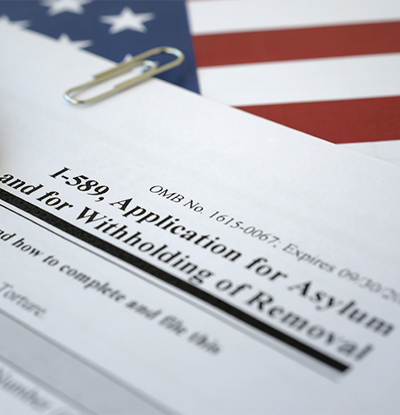MON – FRI (8am - 6pm)
Affirmative asylum is a legal process in the United States that allows individuals who fear persecution in their home country to seek protection without being in removal proceedings. This process is accessible to those who are already physically present in the country, regardless of how they arrived or their immigration status.
Applicants must file Form I-589 within one year of their last entry into the U.S., unless there are exceptional circumstances. If their application is denied, they can renew their petition in immigration court through the defensive process. If you need legal advice, we have expert attorneys in asylum.


The affirmative asylum process in the U.S. has strict deadlines. One of the most important is the requirement to file Form I-589 within the first year of the last entry into the country.
There are exceptions to the one-year rule, such as changing or extraordinary circumstances that justify the delay. These must be documented and clearly explained in the application to be considered.
In addition to the initial filing, applicants will receive notices for biometric appointments and interviews, which must also be attended within the established timeframes. Failure to attend these appointments without valid justification may result in the denial of the application or the referral of the case to an immigration judge.
Affirmative asylum applicants have the right to be represented by an attorney or accredited representative throughout the process, including the interview with the asylum officer and any subsequent proceedings.
During the affirmative asylum process, applicants are protected from deportation. This protection remains in place while the application is pending.
If the affirmative asylum application is denied and the applicant does not have valid immigration status, the case will be referred to an immigration judge. At that point, the applicant can continue their case under the defensive asylum process, maintaining protection from deportation until a final decision is made.

The affirmative asylum process in the United States is subject to frequent changes in laws and regulations. For example, the Circumvention of Lawful Pathways (CLP) rule has impacted the eligibility of certain applicants entering through the southwest border, imposing additional restrictions. Additionally, the policy regarding interpreters in asylum interviews has reverted to requiring applicants to bring their own interpreters, following the end of a temporary rule implemented during the pandemic.
It is crucial for applicants and their legal representatives to stay informed about these regulatory updates, as they can significantly affect the asylum process. Recent court decisions and changes in immigration policies may alter requirements, deadlines, and procedures; therefore, having an experienced asylum attorney is essential. Do not hesitate to contact serving immigrants to ensure your affirmative asylum case is handled properly with up-to-date expertise.
Learn who is eligible to apply for affirmative asylum in the U.S., including the specific criteria and conditions that must be met for consideration.
To be eligible for affirmative asylum in the U.S., the applicant must be physically present in the country and demonstrate a well-founded fear of persecution in their home country due to their race, religion, nationality, membership in a particular social group, or political opinions.
See if you are eligible to file a Form I-589
The affirmative asylum process requires the applicant to file Form I-589 within the first year of their last entry into the U.S. This deadline is strict, unless there are exceptional circumstances that justify a delay in filing. See how it looks.
Additionally, the applicant must not be in removal proceedings at the time of the application. If the applicant is in legal status, they should understand that their case may be referred to an immigration judge if the application is denied.

During the affirmative asylum process, applicants have the right to remain in the U.S. while their case is pending, as well as the right to be represented by an attorney or accredited representative. They also have the right to apply for work authorization if their application has been pending for more than 150 days
However, applicants also have obligations to fulfill. They must attend all scheduled appointments, including interviews and biometric appointments. They have to provide all necessary documentation and any additional information requested by USCIS in a timely manner. Failure to meet these obligations can result in the denial of the application or referral of the case to an immigration judge for removal proceedings.
To apply for affirmative asylum, several key documents must be submitted to support your case. These documents include proof of identity, evidence of persecution, and documentation related to your immigration status in the U.S.
Passport, identity card, birth certificate, or other official documents that confirm your identity and that of your dependents if included in the application.
Police reports, medical evidence of injuries, photographs, testimonies, letters, and other documents that demonstrate your fear of persecution in your home country. It is also helpful to include country condition reports issued by human rights organizations.
A written document explaining in detail the reasons why you are seeking asylum, including personal experiences of persecution or a well-founded fear of persecution if you return to your country.
Any visas, such as a tourist or student visa, or Form I-94 showing your current immigration status in the U.S.
Form I-589 is the official application for asylum in the U.S. and for withholding of removal. It must be filed within the first year of the last entry into the country.
If you have had previous contact with the U.S. immigration legal system, include Notices to Appear (NTA) or other relevant documents.
Affirmative asylum is proactively sought by individuals who are not in removal proceedings, submitting their application directly to USCIS. In contrast, defensive asylum is sought as a defense against deportation when an individual is already in proceedings before an immigration judge. If affirmative asylum is denied, the case can be transferred to the defensive process, allowing the applicant to defend their case in immigration court to avoid deportation.
This ensures that you fully understand the requirements and avoid omitting crucial information in your application.
Ensure that all the information provided is correct and complete, including details about your situation and that of your dependents.
Check for any typographical or informational errors.
Do not omit any evidence that can strengthen your application, such as proof of persecution and documents that corroborate your story.
If a question does not apply to your case, indicate "N/A" instead of leaving it blank to avoid having your application rejected for incompleteness.
An unsigned form will be automatically rejected, which can delay your asylum process.
Notify them immediately of any changes in your address or situation to ensure you receive all communications.
Ensure that all document translations are correctly certified to meet USCIS requirements.
Consulting with an immigration attorney can help ensure that your application is complete and correct, contact serving immigrants.
Explore essential information in our asylum visa FAQs, made to answer your most pressing questions with clarity and ease:
It’s not mandatory, but highly recommended to have legal advice. If you need help with your case, contact us; we have the best attorneys in affirmative asylum.
Yes, you can include your spouse and unmarried children under 21 who are physically present in the U.S.
It is a letter explaining why your application may be denied; you have 16 days to respond with more evidence or arguments.
You can request an extension, but it’s best to do so only if absolutely necessary. See more on USCIS.
It can take several months to years, depending on the caseload and location.